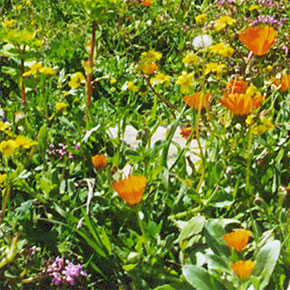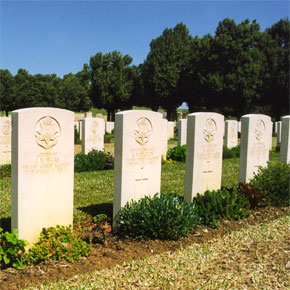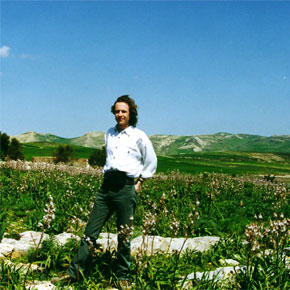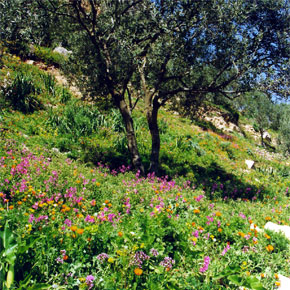Tunisia
Stepping-stones in the ocean
Behind me, the village of Chaouach, a fragile almost destitute settlement from where I have just wandered, clings to its rocky outcrop like a fledgling bird. I stand facing North, overlooking a verdant landscape glistening with bugloss that rolls in gently unfolding swathes towards its summit, Jebel Ang, three kilometres distant. A meandering horizon separates us from a single tone of brilliant cerulean sky, cloudless and virgin. Thirty metres ahead and slightly to my left, a farmstead stands so isolate and forlorn it would be easy to miss, its careless pen indifferently enclosing a few chickens, a donkey. Disturbed by the bark of her dog, a woman looks out from its tumbledown door. We wave acknowledgingly to each other, then she turns inside. To my right and to the East, the land falls away sharply with distant views over the Mejerda valley and the town we have just climbed from, Mejez el Bab. Over my left shoulder, a slope of olive trees carpeted with marigolds, poppies, forget-me-nots rises to a sandstone bluff from where the empty portals of Byzantine rock tombs survey the clear air. A honey buzzard circles overhead.
My odyssey here finds its origins in two discrete circumstances.
I live, for the time being, in Sicily and on the past few occasions I have returned there, it has been by car from Rome, along the western coast of the peninsula. Like a child who scales the garden wall for the first time, my curiosity to come to Tunisia was stirred by a simple desire to go one step further, to see Africa with my own eyes.
My journey to this lip of rock however, has its roots elsewhere.
Here, at the steps of Jebel Ang, I am overlooking the battlefield where my grandfather fell on 15th April 1943. The evidence of that battle has now all but disappeared, the evidence of war grown over, but I recall the graves we earlier walked among in the War cemetery at Mejez el Bab. I picture them now, not as the regiments of white marble tombstones standing to attention, but slain here on this steppe-like plain as the mutilated corpses of young men. The calamity stretches way beyond my brow of vision. It is too hard, yet imperative, to imagine what machines of war once pounded this peace with shells, what nightmare once unfolded here, what incubo was unleashed. It is harder still to understand what these two armies were fighting over. A hill. Thousands of kilometres from either England, or Germany.
It is early April. Had I been here at dawn, facing the sun as it edged above the horizon, slightly north of East, I would have been staring in the direction of Tunis, only fifty kilometres distant, and almost in sight at this elevation. In a direct line, only two hundred and fifty kilometres beyond, is the coast of Sicily and, on that spring morning fifty-six years ago, the Allies’ objective. It is along this very line, between Cap Bon in Tunisia and Marsala in Sicily that the Mediterranean sea angles like a craning neck, constraining ships plying an East-West route to alter direction. After Gibraltar and the Dardanelles, it is the narrowest strait in the Mediterranean. Carthaginians, Romans, Byzantines, Arabs, Turks and the Spanish, corsairs and pirates, all of them, in various pasts have battled for command of this strait. During World War II, it was the Germans who had taken control of it to protect their shipping in the Mediterranean and the Allied invasion of Italy relied crucially on the First Army’s success in breaking the German’s stranglehold. After months of journeying through Algeria, their penultimate obstacle to the port of La Goulette at Tunis was the hill where I now stand, Jebel Ang. In the battle for which, my grandfather was one of the last to fall.
With me, I have a photocopy of a moving, heart-felt and intensely personal letter written on May 13th 1943, soon after the fall of Tunis, from the Battalion’s Commander to my grandmother. I re-read it aloud to myself, though I almost know it by heart. “Patrols were sent out… round the sides of the hill to see whether the enemy remained in occupation…. Unluckily the Hun was lying up still in the trenches, and as the patrol rounded an angle of the hill they were heavily fired on at close range. Your husband, who was leading, was hit and killed instantly.”
I read it aloud to the wind. It makes no sense in this paradise.
Chewing this sombre thought over in my mind, I turn to walk back to the village. Passing the Byzantine rock tombs, then, lower down, the Muslim cemetery with its white, bed-shaped tombs amidst a saturnalia of spring flowers, I recall the British War Cemetery we visited earlier that morning, its lyrical tone of English pastoralism. The way we remember our dead reveals much about what we value in life.
A girl and woman pass us. (Do they not wonder what we are doing here?) They salute us in French, which I interpret as a welcome, and I instinctively reply likewise though we have learnt the Arabic salutations. The woman is middle aged, her face hidden by her sisfari, a light woman’s head shawl, which she grips between her teeth in the manner of Tunisian women. (Though women in Tunisian villages often wear headscarves, I was struck by how few one sees in the cities, far less for example, than the numbers of headscarfed women to be seen in Turkish cities.)
I am arrested by the girl’s twilight face, youthful, but not callow, and shaped like those gentle horseshoe-arched doorways so characteristic of Tunisia. Her eyes like petrol, circled by large albumous whites, parentheses ‘< >’ to deep, vispid irises. Her eyelashes, long and curling like Arabic calligraphy. Her nose, an italicised ‘l’. Her cheeks, flat expressionless plains, which rise like sand dunes as she smiles to greet us. Her skin, the bronzed tone of a young Cleopatra. Her hair, straight and long, coarse, but not black or kohl-coloured. In this morning light, it shines almost reddish. Maybe only sixteen, she is dressed in trousers and a jumper that would not be out of place in Paris.
Further down, a group of men has gathered to examine a donkey that has hit upon some misfortune. One of them, dressed in a burnouse or heavy men’s cloak, is gesticulating wildly, stabbing his cigarette at the air. They are too preoccupied to look up as we saunter past them.
Once again we are back among houses, none of them more than a single storey high. It is impossible to tell how old they might be. Maybe they have stood here for centuries, but equally, they could have been built yesterday. I wonder what these villagers would have been doing that April morning fifty-six years ago. Some of them would be old enough to remember the event. Surely they would have evacuated their village? How would they have explained the presence of two such colossal armies fighting over a piece of their grazing land?
We arrive back at the village square, a dusty space delineated along its edges only by the knots of tea-drinkers, all of them men, who are gathered at the café, as they no-doubt are every morning. The scene is a lightening antidote to the thoughts that cloud my mind but our driver is waiting on the opposite corner. He has already backed his car up, as if looking for a speedy getaway from this windblown top.
Later, on the bus back to Tunis, my head is filled with introspective thoughts, of which I want only to divest myself. Unusually, to gather from the other experiences of Tunisian buses we have had, there is an eerie silence among the passengers, none of the perpetual Arab music that characterised all our other journeys. In atmosphere, it reminds me of the immense sense of calm that can prevail on a Turkish bus. I recall the journeys between Ankara and East Anatolia where I have sat for hours, whole days almost, without hearing more than the gentle tones of a mother whispering to her child, the sound of so much smoking.
I have walked past three cemeteries today. I am possessed by death. A question looms large in my mind. It is one that has been so eloquently phrased by Barry Lopez in his writings about Eskimos: what do these people see where I see death? A question for which there exists no corresponding answer, but in trying to understand a culture, is one we must ask ourselves constantly.
What is it to really know a culture? To know how these people die, marry, give birth, make love, eat, clean themselves, show emotion, express value, earn money?
It is one thing to observe what a people do. It is quite another to understand what they are doing. From simply observing a culture that is alien to us, we cannot know these things. We can only guess, make assumptions, arrive at hypotheses, speculate. See the surface of things.
Back in Tunis it is already late afternoon. I am getting hungry. We head into the Medina in search of chawarma and a freshly squeezed orange-juice.
The Medina has a pull of its own. Its street patterns, like an Indian mantra draw you up into another world upon which your concentration becomes fixed. We push down the main thoroughfare, Rue Jemaa Zitouna. There is no chawarma to be had here. Instead, lining the street are the jumbles of stalls selling all the worst type of tourist junk, cheap Moroccan pottery, Hammamet candlesticks, cuddly camels, toy swords, ornamental drums. Who, I ask myself, would possibly want to buy any of this stuff, let alone keep it at home in their living-room? The things that tourists are prepared to buy, reveals too much about the culture I come from. This is no longer a place where people trade and live simultaneously. It is a place where tourists come to shop, before retiring back to the comfort of their hotels, where they will not be expected to haggle over the price of what they buy. We head off quickly into the labyrinth of narrow, winding streets, apparently so typical of medieval Arab cities. After ten minutes of wandering we stop an old man, pushing a bicycle and wearing one of those ubiquitous Tunisian chéchia, a red felt hat, worn by many of the older men. We ask him where we can find something to eat. For a moment he looks at us out of beady eyes before wheeling his bicycle round and beckoning us to follow. Only then do I understand the bicycle. On its rear-pannier is balanced a bag of vegetables - his answer to a shopping trolley. For more than several hundred metres, often out-pacing us, he leads us out of his way. At a certain juncture, he beckons us to head off down a side-street, then continues on his way. We ask him to join us, but his mind is already made up. On the angle of a street corner, so undistinguished in its apparel as to be easily missed, we find the vertical spit of chawarma, visually so similar to the Turkish döner but in taste spicier, more thirst-making.
The buildings in the Medina are low and rarely more than two storeys high. What lingers in the mind is the predominance of blue. Not just of the sky against the whitewashed walls, but of the painted window frames, the woodwork of the houses, the horseshoe-arch of the doorways, set with black studs, often in the shape of ‘The Hand of Fatima’ or a fish, both symbols to guard against the Evil-eye.
We wander through the labyrinthine passageways, occasionally passing a café, obscured, clandestinely in a corner and filled with the cadres of men each hunched over his hookah. Then, unannounced, the walls of the tapering streets close in on us, the sky darkens and the passageways become tunnels through a twilit city where the dusty air has the scent of cinnamon. We have stumbled into the souks. Small doors, the height of a stooped old man, open into the tiny workshops of drapers, weavers, cloth merchants. Inside his atelier, a tailor sits cross-legged amidst a plume of cloth, straining his eyes in the meagre light to sew. A single, bare, sixty-watt bulb draws delicate shadows from the corners of his workshop. Colours that would seem brilliant under the desert sun, smoulder as mere pastels. In an adjacent workshop, an elderly, bearded man sits addressing another. His shop is devoid of wares. He has nothing to sell. In a third, a sage reads from his Koran. He has no customers.
It is late in the day and the vendors are closing their shops, but the resignation apparent in their movements makes you wonder if the morrow will see them bother to return to unlock their shutters. I notice the sad bolt over a tired, squinting door, the face of a shop that has nothing to sell. Today these are backwaters. Where nobody comes. It is a sobering contrast to the Rue Jemaa Zitouna and the lines of cuddly camels, to where the coach-tour parties are funnelled like rainwater and money slips from Europeans’ hands like litter dropped in the street.
My wife stops outside one of the shops. She steps inside to examine more closely a square of cloth that has caught her eye. She begins to bargain for it. Haggling is a skill I do not have, but she, being Sicilian is the Tunisians’ equal. In that respect, I reflect candidly, she is closer to their culture than I am. They bargain in Italian. A price is arrived at. A tenth of the quoted original. I open my wallet stuffed full with five dinar notes and am greeted by the smell of grubby money, those great pretentious swathes of paper worn smooth with touching. I hand over two dinar coins. The vendor takes them appreciatively. We both know it is not a large sum of money, but he smiles to my wife. He was happy to have spoken in Italian. His grandmother, he proudly tells us, was Venetian. It explains his affinity with the country whose language he speaks yet which I doubt he has ever visited. Our mutual salutations as we leave his shop are heartfelt.
A thought touches my conscience.
Had we been Christian merchants arriving in Tunis in the sixteenth century, we would have brought with us, not dinars, nor lire. Not even silver. But salt. And we would have exchanged it not for cloth, but gold. It was an interested purchase. In Medieval Europe, trade with the Far East was only possible with exports of gold and silver, but despite its lucrative rewards, the traders’ voracity had been such that, by the mid 1500s, the Mediterranean bullion reserves were ruinously depleted. The reversal of this process came only with the arrival of Sudanese gold in North Africa and the commodity the Europeans traded for it was nothing more humble than the proverbial salt. Christian merchants based in cities such as Tunis carried their salt in camel caravans across the Sahara to meet the canoes arriving from the South. It is said that in 1450 in Mali, salt was exchanged for its weight in gold - a notion that today would strike most of us today as gruesomely absurd.
The irony of our point of departure now becomes apparent - since we arrived in Tunisia by boat, from Trapani on the west coast of Sicily.
And my conjecture is this. That the origin of much of that salt was the place we have just arrived from. Trapani.
In Trapani, salt beds stretch from the port as far as the horizon. Flooded with sea water, which is then left to evaporate beneath the Sicilian sun, the residual salt is later collected, today to be sold in Italian supermarkets.
It is worth reflecting that Trapani, not only geographically, but also historically and culturally finds more allegiance with Tunis than it has with say, its present capital Rome, or God-forbid, Brussels. Trapani, and its sister, Tunis belong to two diverse continents, two different geographical plates on the earth’s surface, yet even linguistically they hold things in common. As a legacy of the island’s history, Sicilian dialect and vocabulary derives much from Arabic. My favourite example is that of the humble cherry (itself a derivation of the French cerise - also from the Arabic). In Sicilian the word is jirazi (to Anglicise its spelling for the sake of my reader), a word I recognised from the Turkish kiraz - in Anatolian dialect jiraz - from the Arabic kareez or the Greek kerasos. In Italian the word is simply ciliege - the origin of which, I know not.
It is here, in the Medina, where the Tunisian culture is exposed at its edges, since in the market-place a society is constrained to diffuse its boundaries, its values, its needs, its concerns. Only in the market-place, through the act of trading, do material goods acquire value, as objects, previously unmeasurable, are measured, first by vendor, then by purchaser and the process repeated until agreement is reached. I think of the coins change hands in the Medina today. Here, coins, currencies, like languages, are plural.
That I visited Tunisia only for a week may say rather more about the culture I come from than I myself am able to say about the culture I visited. It is axiomatic of modern tourism that we “do” one country after another in a quick succession of whistle-stop holidays. (Most of the other tourists you see in Tunisia are either French, German or Italians. You see, for example, very few Arab tourists.) But first impressions, so long as we understand their limitations, are also valuable. Very often they do show certain truths. To spend only a short time in a country is not to demean the experience.
Most European tourists who travel to Tunisia make the journey by plane. But in doing so they miss one of the country’s most important faces. This year [1999], Easter and the Muslim festival of Aid el Adha coincided all but a week from each other and the Tunisians living in Sicily had made use of these two festivals to visit their families. We were, returning on the ferry to Trapani that night, maybe six hundred Tunisians, a few dozen Europeans. Almost all the Tunsians were men. It was something we had got used to in Tunisia.
As a traveller to a country, the role-call of people one encounters is predictable: taxi-drivers, hotel porters, chefs, waiters, salesmen, store owners, bus-drivers and so on. In Tunisia, almost all of these had been men. Men, it seems, are the face of Tunisian society one is most likely to meet. They are also the face which Tunisian society sends out into the world.
As the ship slipped anchor from La Goulette and made headway beneath the evening stars, the Europeans eyed their compatriots’ suntans and bags of souvenirs with varying degrees of jealousy and envy, then turned into their cabins to sleep. Not yet tired, I took a stroll to the air of one of the upper decks. There, huddled in tight constellations around picnics of seemingly universal roast chicken, is a galaxy of Tunisians, camped out on whatever space they can find, smoking, chatting, eating and drinking their way through the night. Their alignments seem to change every few minutes as one or other of them moves away to make conversation elsewhere. I doubt they all know each other, but they are content to pass the time of night with each other.
I stand in the stern of the ship watching its wake grow longer from Africa. Its wash, a transitory path in the ocean. I think back to the honey-buzzard that circled overhead as I stood vigil on Jebel Ang. At this time of year, the honey-buzzard, Europe-bound along with the thousands of other migrating birds, traces this same route - a line so ancient it transcends even the histories of brittle empires who have once battled for command of this straight. And by a strange connectedness, the arc of these journeys describes a locus as deeply etched on the surface of our planet as the Appian Way or the Silk Routes to China. In the course of time, I muse, the peoples who have plied this route have been many. Tonight, it is the Tunisians who make this journey along that imaginary causeway between Tunisia and Sicily. A stepping-stone in the ocean. For which my grandfather lost his life.
Looking out onto the calmness of the sea, I would like to believe he gave his life that this apparent causeway might remain open to the flow of ideas. That the metaphorical salt might still in the future be exchanged for gold. And that, like the honey-buzzard, that gold will travel both ways.
Tired from a long day, I carry this thought to my bed.
But my story has an unfortunate end.
The Tunisians had had their green passports taken from them as they boarded the ship (why, I was never able to ascertain). Sadly and profoundly, our differences were to be further delineated the following morning. Now, they are herded to one end of the ship where, who knows how their passports are returned to them? Their names called out in some Italicised Arabic, maybe? I don’t know. I am too much embroiled in the equally routing scrum of obtaining a stamp in our own claret-coloured European passports at the other end of the ship. The chaos and hot tempers are almost too much to bear.
Trying to be patient, I eavesdrop on the conversations of irate fellow passengers and my ear homes in with embarrassment on a Roman accent, one of the ‘Desert Convoy’ who had taken their Land Cruisers for a week in the Tunisian desert. He is talking about clandestini - the word used all too partially in Italian to describe anyone who arrives illegally.
Sicily, might be the unemployment capital of Europe, and it is understandable that the inhabitants here feel resentment towards the situation, but most of these Tunisians who are bound for Sicily will work in jobs that they themselves have created. Very few Sicilians sell tissues at traffic lights.
Nor is it right to think of this as an ‘invasion’, as this Roman infers.
Culturally and historically the Mediterranean has defined itself by the trade that takes place there, and by the reciprocal traffic of peoples, goods, ideas, between its shores. Our truism of thinking of Mediterraneans as being similar in temperament, all with olive skin and dark eyes who jealously guard their women has behind it the crucial but rarely stated assumption that the Mediterranean itself is a country. And to be Tunisian is, amongst other things, to be Mediterranean.
I think back to the Medina in Tunis. These Tunisians who disembark from our ship are only doing what the population of the Mediterranean has been doing ever since man first devised a boat that floated and was secure enough to sail across the sea. And what the Christian merchants did in settling in Tunis in the fourteenth to sixteenth centuries.
In disembarking from this ship, it is the Tunisians, more than any tourist, who maintain that definition of the Mediterranean as a cultural entity and in doing so reaffirm what it is to be alive.




